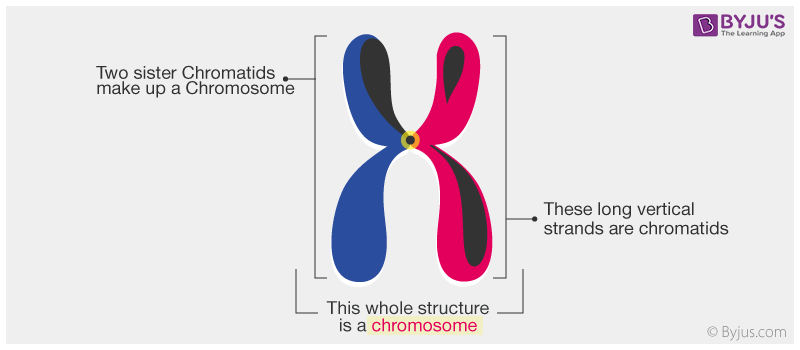Table of Contents:
What are Chromosomes?
Chromosomes are components of a cell nucleus that are capable of self-reproduction. These chromosomes play an important role in mutation, variation, heredity, and the evolutionary development of a species. Moreover, the chromosome number is constant for a particular species.
Humans have 46 chromosomes arranged as 23 pairs. Here, 22 pairs are autosomes or body chromosomes and the 23rd pair is allosome or sex chromosome. Let us learn more about the structure of the chromosome with the help of a diagram.
Diagram Showing Chromosome
Chromosomes are usually not visible under a normal microscope. They are mostly viewable only during cell division under a light microscope.
Chromosomes are tightly packed thread-like structures that are composed of DNA. These DNA are compactly coiled around proteins known as histones. The compact complex of DNA and its associated proteins is called chromatin. A subunit of this chromatin is termed a nucleosome.

Chromosome Structure

- Each chromosome has 2 symmetrical structures during mitotic metaphase. These structures are termed chromatids. Each chromatid comprises a single molecule of DNA.
- The 2 chromatids are joined at the centromere. The chromatids get separated during anaphase when they move to opposite poles.
- Each centromere divides the chromosome into 2 arms. The shorter chromosomal arm is termed ‘p’ and the longer one is ‘q’.
- Based on the position of the centromere, the chromosome shape can be – metacentric, submetacentric, acrocentric and telocentric.
- Metacentric is a V-shaped chromosome where the centromere is central, and thus the two chromosomal arms are of equal length.
- The centromere is slightly off-centre in the submetacentric. It results in unequal arms and thus, the chromosomes are J or L shaped.
- In Acrocentric, the centromere is almost at the top of the chromosome, resulting in a very short and long arm.
- In Telocentric, the centromere is at the proximal end and gives the chromosome a characteristic I-shape.
- Sometimes (in mitotic prophase), the chromosomes are seen as thin filaments known as chromonemata. It almost resembles a chromatid. Chromonemata is the gene-bearing structure of a chromosome.
- Sometimes (in interphase), bead-like accumulations of chromatin material are visible along the chromosomes. These are termed as chromomeres. These are regions of tightly-packed DNA.
- Usually, the centromere lies within the primary constriction (thinner chromosomal segment). Under an electron microscope, a small disc-shaped structure appears on the centromere or primary constriction called the kinetochore. These kinetochores are protein structures associated with the sister chromatids. They aid in the assembly of microtubules.
- Chromosomes also show secondary constriction besides primary constriction. Other than centromere, any other narrow constriction is termed secondary constriction. Certain regions in the secondary constriction that have genes to form nucleoli are called nucleolar organisers.
- The extreme part of the chromosome is called a telomere. Telomeres have polarity and thus prevent the fusion of other chromosomal segments.
- Sometimes, chromosomes contain knob-like appendages called satellites. Such chromosomes are called sat chromosomes. Here, the satellite is connected with the rest of the chromosome through a thin chromatin filament.
Functions
The chromosomes are significant in carrying hereditary information from one generation to another. The sole genetic material is the DNA and it forms a permanent component of the chromosome.
Apart from that, chromosomes also play a vital role in the gene expression, growth, repair, and regeneration of a cell. Any deformity in the normal chromosomal content will cause diseases like Down’s syndrome and Turner syndrome.
Frequently Asked Questions
What are autosomes and allosome?
Humans contain 22 pairs (labelled from 1 to 22 in numbers) of autosomes and one pair of allosome or sex chromosome. The allosome is denoted as a pair of X chromosomes (females) or one X and one Y chromosome (males).
What is the difference between genes and chromosomes?
Chromosomes are thread-like cell components that contain genes. A single chromosome is packed with many such genes that are in turn composed of either RNA or DNA. Gene is a segment of DNA that carries information for a particular trait.
Related Topics:
Keep exploring BYJU’S Biology for more such exciting diagram topics.
Comments